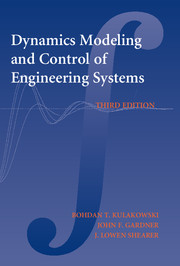Book contents
- Frontmatter
- Contents
- Preface
- Dynamic Modeling and Control of Engineering Systems
- 1 INTRODUCTION
- 2 MECHANICAL SYSTEMS
- 3 MATHEMATICAL MODELS
- 4 ANALYTICAL SOLUTIONS OF SYSTEM INPUT–OUTPUT EQUATIONS
- 5 NUMERICAL SOLUTIONS OF ORDINARY DIFFERENTIAL EQUATIONS
- 6 SIMULATION OF DYNAMIC SYSTEMS
- 7 ELECTRICAL SYSTEMS
- 8 THERMAL SYSTEMS
- 9 FLUID SYSTEMS
- 10 MIXED SYSTEMS
- 11 SYSTEM TRANSFER FUNCTIONS
- 12 FREQUENCY ANALYSIS
- 13 CLOSED-LOOP SYSTEMS AND SYSTEM STABILITY
- 14 CONTROL SYSTEMS
- 15 ANALYSIS OF DISCRETE-TIME SYSTEMS
- 16 DIGITAL CONTROL SYSTEMS
- APPENDIX 1 Fourier Series and the Fourier Transform
- APPENDIX 2 Laplace Transforms
- APPENDIX 3 MATLAB Tutorial
- APPENDIX 4 Simulink Tutorial
- Index
6 - SIMULATION OF DYNAMIC SYSTEMS
Published online by Cambridge University Press: 05 June 2012
- Frontmatter
- Contents
- Preface
- Dynamic Modeling and Control of Engineering Systems
- 1 INTRODUCTION
- 2 MECHANICAL SYSTEMS
- 3 MATHEMATICAL MODELS
- 4 ANALYTICAL SOLUTIONS OF SYSTEM INPUT–OUTPUT EQUATIONS
- 5 NUMERICAL SOLUTIONS OF ORDINARY DIFFERENTIAL EQUATIONS
- 6 SIMULATION OF DYNAMIC SYSTEMS
- 7 ELECTRICAL SYSTEMS
- 8 THERMAL SYSTEMS
- 9 FLUID SYSTEMS
- 10 MIXED SYSTEMS
- 11 SYSTEM TRANSFER FUNCTIONS
- 12 FREQUENCY ANALYSIS
- 13 CLOSED-LOOP SYSTEMS AND SYSTEM STABILITY
- 14 CONTROL SYSTEMS
- 15 ANALYSIS OF DISCRETE-TIME SYSTEMS
- 16 DIGITAL CONTROL SYSTEMS
- APPENDIX 1 Fourier Series and the Fourier Transform
- APPENDIX 2 Laplace Transforms
- APPENDIX 3 MATLAB Tutorial
- APPENDIX 4 Simulink Tutorial
- Index
Summary
LEARNING OBJECTIVES FOR THIS CHAPTER
6–1 To know the common elements of computer simulations.
6–2 To be able to build block diagrams of systems based on the model equations.
6–3 To become familiar with the basic block set of Simulink.
6–4 To understand different approaches to simulation utilizing different features of Simulink.
6–5 To be able to simulate both linear and nonlinear systems.
6–6 To be able to simulate configuration-dependent systems.
6–7 To be able to conduct parametric studies of systems through scripting multiple runs of the simulations.
INTRODUCTION
System simulation is one of the most widely used tools in modern society. From weather forecasting to economic analysis, from robotics to computer animation, simulation is becoming a commonplace tool for analysts and designers of all types, not just engineers. Yet, as widespread as these applications are, the fundamental basis of system simulations is common. A computer simulation is a numerical solution of a set of differential equations that are intended to model the way in which a particular system evolves in time.
In Chap. 4, techniques for the analytical solution of differential equations were presented. These methods represent a powerful set of tools for the study of linear dynamic systems. It was shown that by simply inspecting the coefficients of a first- or second-order characteristic equation, the entire characteristic of the step response could be predicted. At this point, it would be fair to ask the question: Why are computer-based methods for finding the responses of dynamic systems needed?
- Type
- Chapter
- Information
- Dynamic Modeling and Control of Engineering Systems , pp. 141 - 167Publisher: Cambridge University PressPrint publication year: 2007

